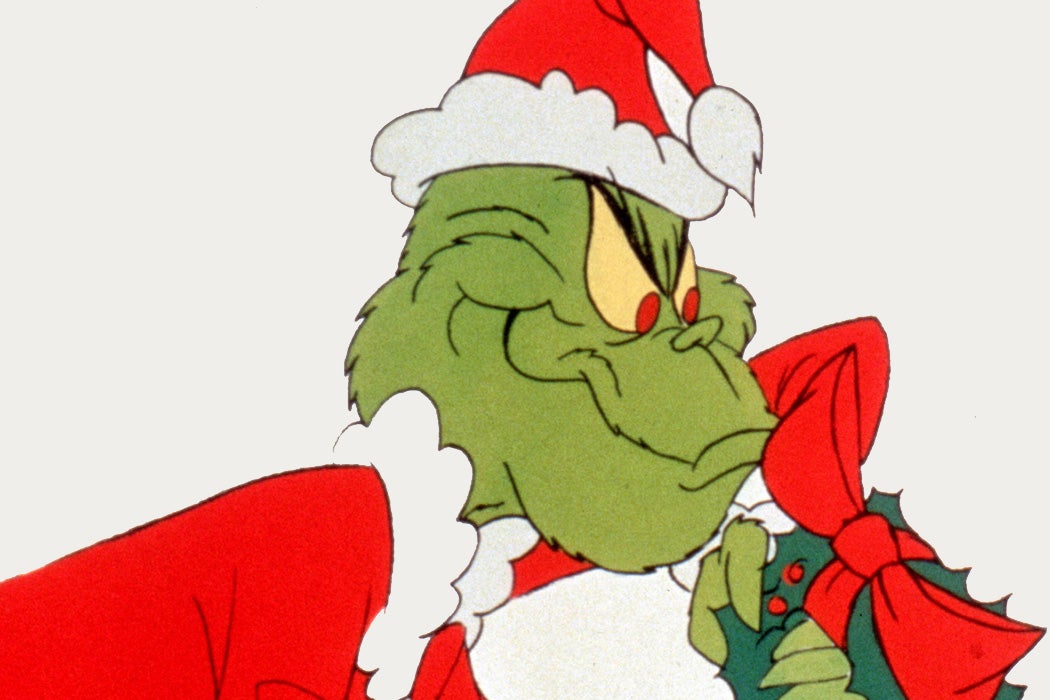In his sweeping conceptual history of anti-Jewish thought, the historian David Nirenberg has suggested that “Judaism” has long served as a “category, a set of ideas and attributes with which non-Jews can make sense of and criticize their world.” It was through the category of “Jewishness” that, for instance, Scrooge offered Dickens a tool for criticizing the injustices of his own industrialist world, as the literary scholar Deborah Epstein Nord writes in Victorian Literature and Culture. In the same way, Dr. Seuss’s Grinch, the Scrooge of the twentieth century, offered a digestible criticism of the hypocrisy and excess of America’s post-war economic expansion. His plot to steal Christmas takes aim at its frivolous merchandise (“Pop guns! And bicycles! Roller skates! Drums! Checkerboards! Tricycles! Popcorn! And Plums!”) and frippery (“The ribbons! The wrappings! The tags! And the tinsel! The trimmings! The trappings!”). The 2018 Grinch movie, narrated by Pharrell Williams, makes this economic theme even more palpable. In the new plot, the Grinch story unfolds as Cindy Lou Who seeks out Santa to ask him to help her mother, an overworked single mom. If Santa can be a savior, salvation means freedom not from sin but from wage labor. In both movie and book, the Grinch’s transformation is premised on his realization that “Maybe Christmas… doesn’t come from a store.” Ironically, this new adaptation of Dr. Seuss’ 1957 classic How the Grinch Stole Christmas became an instant commercial success, raking in more than half a billion dollars in just three months.
Weekly Newsletter
In Colossians (3:5–11), Christians are urged to “put to death” their “earthly nature” (including “greed, which is idolatry”), to shed their “old self” and “put on the new.” As the historian of religion Daniel Boyarin notes, for Christian writers like St. Augustine (d. 430), to cling blindly to one’s old ways was to commit the specifically Jewish sin of legalism and literalism, the sin of “Carnal Israel.” In medieval Christendom, where Jews were often pressured to work as tax collectors and lenders for Christian sovereigns, this led to an association between Judaism and money. The first anti-Semitic caricature of a Jew as a hook-nosed usurer appears in a doodle on an English tax receipt roll in 1233. As the historian Lester Little explains, after the mercantile boom of the twelfth century, “The Jews functioned as a scapegoat for Christian failure to adapt successfully to the profit economy.” Grinch’s change of heart on Christmas morning bears all the signs of a religious conversion, a turning away from malice and materialism to embrace a new law of charity and community.
What is the Grinch? He lives outside of town. He is unnaturally out of sync with others, for “every Who down in Who-ville liked Christmas a lot, but the Grinch, who lived just north of Who-ville, did not.” He hates their singing; he hates their food; he hates their do-gooding fellowship. The Grinch is a misanthrope who revels in his meanness (“Pooh-Pooh to the Whos!”). His inhumanity reaches a climax when he relishes the notion that the Whos will all cry in sadness when they realize the destruction he has wrought (“‘That’s a noise,’ grinned the Grinch, ‘that I simply MUST hear!’”). Such depravity seems to have its roots in the meagerness of his own heart (“two sizes too small”). Grinch’s righteous jeremiad against consumerism amounts to a cold-hearted crusade against happiness.
The depiction of the Grinch is in keeping with the medieval tradition of viewing the Jew as both an outcast and a baleful force in society, one who is unable to recognize Jesus as the Messiah and who is also stubbornly unwilling to try. This stubbornness is incomprehensible to the virtuous: “Please don’t ask why. No one quite knows the reason. It could be his head wasn’t screwed on just right.” Seuss’ description of the Grinch calls to mind the words of the twelfth-century French abbot Peter the Venerable, who considers why Jews, with their “heart of stone,” reject both logical arguments and biblical verses that affirm Christianity: “I do not know,” Peter muses, “whether a Jew is a man because he does not cede to human reason, nor does he acquiesce to the divine authorities which are his own.” In the same way, the Grinch, for “whatever the reason,” in hating Christmas, rejects both sense and custom.
There are other resonances of medieval anti-Jewish stereotypes in other details of the Grinch story. He steals from the Whos’ houses not only the gifts (the signs of their consumerism) but even (gasp!) the stockings and the Christmas tree. His crime recalls the many late-medieval legends of Jewish theft and destruction of Christian holy objects. In a popular song from thirteenth-century Spain, one of the Cantigas de Santa María (Canticles of Saint Mary) , we hear how a perfidious Jew stole a painting of Mary and destroyed it. “There was in the street / a well-made image of Holy Mary, / painted on wood /…A Jew stole it one night / …and desecrated it shamefully. / The devil killed him / and he went to perdition.” As the historian Miri Rubin explains, accusations appeared in Paris shortly after this, charging Jews with stealing the consecrated Host itself from church sanctuaries in order to desecrate it. Such stories multiplied in the later Middle Ages in central and eastern Europe, often with fatal consequences. The accusations made in Wrocław (Breslau) in 1453, for example, led to the torture and burning at the stake of some forty Jews and the expulsion of the remaining Jewish population from the city. Their property was seized and many of their young children were forcibly baptized and given to Christian families.
If the depiction of the Grinch echoes the medieval and early modern caricature of the Jew, who takes diabolical glee in subverting societal norms and desecrating Christian traditions, it also bears comparison with the flipside of that libel: the Jew’s miraculous conversion. This transformation from aggressive persecutor of Christians to faithful convert was first depicted in the New Testament, in the character of St. Paul. Like Paul’s conversion on the road to Damascus (Acts 9), the Grinch’s transformation is instant and radical, turning him from hater of Christmas and desecrater of Who-ville into a full and enthusiastic participant in the Christmas celebration. He returns everything he stole, “and he… HE HIMSELF…! The Grinch carved the roast beast!” (In the later Broadway medley of Seuss themes, Seussical, the reformed Grinch even leads the annual Christmas pageant in Who-ville).

The sudden shift in the Grinch’s attitude and belief is a clear expression of the theme of inversion at work in the Passion narrative more generally, what the historian Karl Morrison calls “the kerygmatic ironies of proportion built into the ideals of conversion.” In other words, according to Jesus’s words in the Gospels, in which “the last shall be first” (Matthew 20:16) and “those who lose their life for my sake will save it” (Matthew 16:25; Luke 9:24), salvation is defined by radical reversal. The twelfth-century German Jew Herman-Judah of Cologne tells of how, after his Christian conversion, he shocked his former friends by preaching Christianity in the synagogue: “Can you imagine how great a stupor of amazement then seized all the Jews who were present when they saw me so strongly assail the traditions of my fathers, when they had hoped that I, a Jew of the Jews, would be their faithful defender?” So the Grinch shocks the Whos when he not only gives up on his plans to steal Christmas, he becomes the one who delivers Christmas, embracing it and taking a prominent place it its celebration. Plus it seems hard to overlook the Trinitarian symbolism, when “The Grinch’s small heart grew three sizes that day.”
Discerning a Christian subtext in Seuss’s parables is uncontroversial. But interpreting it as “anti-Jewish” surely reads against the grain. Even though, as the theater critic Gerald Weales has noted, Seuss was guilty of racist portrayals of Japanese enemies during World War II, he harshly attacked Hitler and denounced Nazi Germany. Theodor Seuss Geisel, who was not Jewish, has been lauded by the law professor Saul Jay Singer as “a champion of the rights of American Jews” and by the writer Eileen Rosenbloom as a “righteous gentile.” He explicitly affirmed that The Sneetches—his tale of a society divided between those marked or unmarked by a green star—“was inspired by my opposition to anti-Semitism.” Today, his works are enjoyed by many Jewish children in Hebrew translation. It is true, moreover, that Seuss confessed that he himself was the model for the Grinch. Seuss wrote about the Grinch “to see if I could rediscover something about Christmas that obviously I’d lost.” Clearly, he did not knowingly set out to employ anti-Jewish themes. On what grounds, then, do we read them in the Grinch story?
The literary critic and historian Hayden White has pointedly asked, “Could we ever narrativize without moralizing?” In the Western tradition, it is difficult, perhaps impossible, to recount any version of the reformation-of-the-villain story without employing the anti-Jewish motifs from which our sense of that familiar narrative arc ultimately derives. To hear echoes of anti-Jewish thought in the Grinch is not to label Seuss as a closet anti-Semite (he was not), or to reject How the Grinch Stole Christmas! as less uplifting than it ultimately is. Rather, it is to recognize that our intellectual habits in conceiving of villainy, materialism, greed, or corruption of any kind—or in fantasizing about overcoming these ills once and for all—are partly indebted to a binary either-or, us-or-them logic, a bad “habit of thought,” in Nirenberg’s words, bequeathed to us by the long history of Christian anti-Jewish myth-making.
The idea of “the Jew”—the outcast, the pariah, the infidel, the proximate enemy in all his forms—has ever occupied a conceptual position so essential to Christian belief, that it has thereby become deeply engrained in the traditions of thought that developed in the cradle of that faith. Anti-Jewish topoi are woven into some of the core elements of Western storytelling, so that even a storyteller like Dr. Seuss can inadvertently make use of them—indeed, can do so even when they run counter to his own values.
As the long history of Christian thinking about Judaism makes manifest, Jews do not need to be present for Christian thought to make productive use of them. The so-called “hermeneutical Jew” of medieval Christian theology, identified by the historian Jeremy Cohen—the blind, stubborn, world-bound legalist whose function in history was to serve as a cautionary reminder to Christians of how not to read the Old Law—developed in a society where few Christians had any dealings with real Jews. Nevertheless, as Karl Marx insisted centuries later, “out of its own entrails bourgeois society continually creates Jews,” a notion epitomized by Jean-Paul Sartre’s dictum that, “If the Jew did not exist, the anti-Semite would invent him.”
The consequence of this admission should not only be cause for disapproval, but also an opportunity for reflection. As Nirenberg suggests, anti-Judaism is a sort of “mask,” a placeholder for a wide array of other ideas, many of which do not have to do with Jews at all. Its power and durability, like those of any conceptual cipher, derive from its capacity to illogically link disparate things below the surface of understanding. Pulling back the masks of thought, not only in their most obvious anti-Semitic forms, but also in their more opaque and distant reflections, offers a strategy for confronting prejudice and illusion that can apply far beyond the context of Christian and Jewish history. And changing our minds is, after all, the very stuff of conversion, the beginning of a new way of seeing the world.







